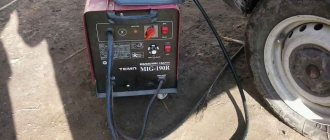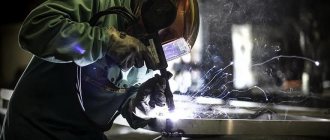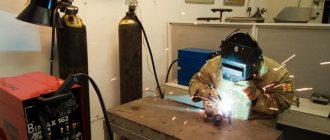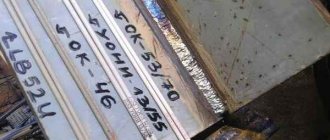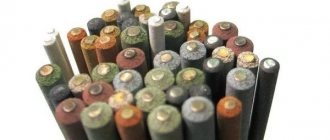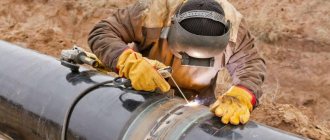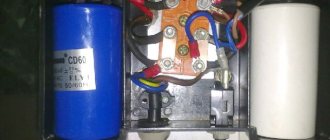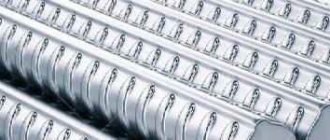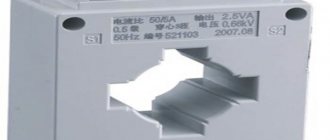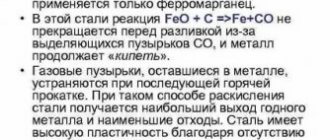Semi-automatic welding with and without gas. Wire. Recommendations.
A
semi-automatic arc arc has advantages over a non-consumable electrode.
- Everyone knows how important it is to carry out the welding process without breaking the arc, maintaining a constant distance between the electrode and the workpiece (arc clearance). If the parameters are set correctly, the semi-automatic device will independently adjust this clearance if there are slight deviations from the optimal position of the burner. In other words, the device takes on half of the tasks that were previously solved primarily by the skill of the welder.
- No need to hold filler material. The right hand is freed, which allows you to freely manipulate the part manually.
- Speed and efficiency increases.
Standard consumable electrode welding consists of:
- inverter power supply (IPS);
- copper-plated wire feed unit;
- special burner
- mass crocodile
- shielding gas cylinder with flow meter.
There are inverters in which the SMPS and the feed mechanism are assembled under one housing. Such devices, operating on the “all-in-one” principle, are most often purchased to satisfy personal needs:
- welding of sheet material (especially thin sheet),
- welding a canopy or gate at the dacha,
- installation of pipelines, etc.
And also for solving special issues, such as, for example, body repair of passenger cars at service stations.
In factory conditions, more powerful equipment is usually used, so the SMPS and wire feeding are separated in them.
The principle of operation of the semi-automatic device is simple: it rectifies the alternating current entering the input into direct current at the output. At constant current, the current vector is determined by its polarity and how the cable is connected to the terminals.
The wire used is designed for a specific polarity. For common wire type 09G2S, “+” DC current is used on the torch.
During the welding process, when the distance from the consumable electrode to the metal changes, the working current and voltage are automatically adjusted so that the arc does not break. The SMPS “tries” to keep the voltage constant while the current increases or decreases.
The feed mechanism block consists of a spindle on which the reel is fixed, and the wire enters the hole of the feed roller through a guide. The feed wheel is designed for a specific wire diameter and can be replaced.
We have examined frequently repeated questions asked by novice welders who are learning to work on a semi-automatic inverter-type machine.
What protective gas is used when working with a semi-automatic machine?
Semi-automatic welding is carried out in a carbon dioxide environment, which is 100% carbon dioxide. You can work exclusively in argon, or in a mixture of argon and carbon dioxide. The welding wire, which is also an additive, is coated with a copper layer to improve electrical contact and smoothness of its feeding.
What should the shielding gas pressure be?
Choose 0.6 ... 0.8 MPa. This is if everything is fine and a new burner is used. If it wears out, you can add a little gas. The main thing is that there are no pores in the weld. If porosity does occur, then the pressure is insufficient (or very high, which can cause air to enter the welding zone, especially when working with an outer corner). Pores can also arise due to “dirty” gas, if there is be wind or drafts. The purity of the gas is especially noticeable when welding aluminum - the seam will simply become covered with a layer of soot and burning. When working with aluminum, choose only high-purity argon.
What wire do you use? What polarity should be observed?
Copper-plated welding wire OK Autrod 12.51 ESAB
The most universal is 08G2S, all welders without exception are familiar with it. It is used for welding low-carbon and electrical steels. Naturally, this material is now sold under various trademarks. The world-famous company ESAB produces 08G2S under the name OK Autrod 12.51 - its composition is strictly controlled, which ensures stable mechanical properties of the seam. Also subject to control is the condition of the copper-plated surface, which is applied in a layer that is not too thick and not too thin, i.e. has an optimal size. Why is it important? Because low-quality wire quickly leads to failure of the feeding mechanism due to contamination with copper dust and chips.
The quality of the wire and copper coating directly determines the condition of the seam and the feed body.
Solid wire welding is carried out using reverse polarity current, that is, the torch is connected to the output with a plus sign. Also for corrosion-resistant steels, the additive ER-308 LSi is used - it contains 20% chromium and 10% nickel - exactly the ratio that gives the weld the greatest resistance to corrosion.
Is welding possible without shielding gas? If yes, what are its features? What are the pros and cons of this welding method?
Flux Cored Self Shielding Wire E71T-GS
It is possible to do without inert/active gases. In such cases, flux-cored wire is used, which is similar in its action to the piece electrode used in manual arc welding.
Flux-cored wire is a hollow tube filled with flux. During combustion, the latter provides the necessary gas protection from external influences for the correct formation of the weld.
Flux-cored wire is also often called flux-cored wire; it is less rigid than regular wire, therefore, in order to work correctly with it without stopping the feed mechanism, it is necessary to loosen the compression force of the roller. Or you shouldn't tighten it too much.
The wire is soft and will wrinkle. In order to avoid such problems, before feeding it for the first time, you should remove the tip on the burner and only then pull it through. Only install a tip of the appropriate size. There is no need to install a nozzle, since welding will be carried out without shielding gas. On the inverter, you should set the voltage, feed rate and inductance parameters using the smooth adjustment knobs.
Another peculiarity of working with such wire is the need to change the polarity on a semi-automatic inverter. The welder must be adapted for this. For example, on the OVERMAN 180 device, the polarity is changed inside the case next to the feed mechanism (the terminals are unscrewed and the wires are swapped). Do not forget also that the size of the feed roller groove must correspond to the diameter of the wire.
Welding a sheet 1-2 mm thick should be done with short seams at an angle back, in which case the seam is formed much better. For welding thin metal, 0.8 mm wire is commercially available. Maximum diameter 2.4 mm – for serious industrial applications.
Advantages:
- no need to carry heavy cylinders, mobility.
Flaws:
- high cost of wire,
- you need to be careful about its quality,
- A slag crust forms on the surface of the seam, which needs to be cleaned off.
Semi-automatic welding
A distinctive feature of this type of welding is the use of a movable consumable electrode (wire) and shielding gas.
It is necessary to protect the electric arc so that the molten metal and the environment do not come into contact with each other, because this process (oxidation of nitrogen and oxygen) entails the formation of components such as oxides and nitrites, which, when entering the metal, lead to deterioration in the quality of the weld. It is for these purposes that cylinders with protective gases are used: with argon, helium, carbon dioxide or mixtures thereof.
Principles of semi-automatic welding using wire
Semi-automatic welding is carried out according to the following principle. A moving live wire is passed through a gas nozzle, then it melts as an electric arc acts on it, but a constant arc length is maintained using an automatic feed mechanism. This is the essence of the automation principle, and the choice of welding direction and speed is carried out independently.
You can weld without using gas. To do this, they use self-shielding (“powder-cored”) wire, which contains manganese, silicon and other deoxidizer metals, the combustion of which creates a protective environment around the wire. welding equipment
The welding installation must consist of the following components:
- burner;
- a hose through which wire and gas are supplied;
- wire feeding mechanism;
- control panel;
- coil of wire;
- electrical wire;
- semi-automatic control unit;
- gas supply hose;
- reducer that reduces gas pressure;
- heater;
- high pressure gas cylinder;
- rectifier.
Connectivity differences
Anyone who has used electric arc welding machines understands that we are talking about the distribution of poles between the holder and the workpiece. There are two types of polarity when welding:
- Direct, when electrons move towards the workpiece (minus on the electrode). The arc turns out compact and dense.
- Reverse, when a plus is connected to the holder. A diffuse area of contact between the arc and the metal is formed.
The main difference between direct and reverse polarity welding is the localization of the point of maximum heating. With direct heat, the metal heats up more, and with reverse heat, the consumables heat up more. The method of connecting the poles depends on the thickness and physical properties of the metal.
Features of straight polarity when welding
First, a few words about the scope of application of straight polarity in welding. It is extensive and is used:
- When installing rolled steel from carbon, low-alloy, special steels using consumable electrodes.
- When welding is performed with a tungsten non-consumable electrode using a surfacing wire. A refractory rod is needed for butt joints of thin parts and non-ferrous metals; it is used when working with fluid alloys.
- For cutting workpieces using welding equipment.
Advantages of current standard terminal connection:
- a narrow suture bead is formed;
- due to the high plasma density, the workpiece is boiled deeply;
- a wide range of surfacing electrodes with various types of coatings is produced;
- a stable arc is maintained.
Disadvantages of direct connection:
- the metal is strongly sprayed (a dense stream of plasma hits the melt pool with force);
- there is a high risk of burning through thin parts;
- residual stresses arise in the heat-affected zone.
So, with a direct connection, the cable from the positive terminal is connected to the workpiece, and from the negative socket it is led out to the electrode holder.
Manual arc welding technology
Arc welding is the most common type of metal welding. The method is universal, technologically simple and allows you to obtain good quality welds in non-production conditions. The electric current of the welding source forms an arc between the workpiece and the electrode. The coating (flux) burns on it, releasing a gas that cleanses the work area of oxygen.
According to the shape and types of connections, welding seams are divided into:
- T-bars;
- corner;
- butt;
- overlap;
- end
Different angles of inclination of the electrode allow you to create different types of seams. The most convenient interval is between 45 and 90 degrees, at which the weld pool is completely visible. With experience comes an understanding of exactly how to change the angle of inclination.
Typically, welding machines are equipped with a ground cable with a clamp-type holder. At first glance, it is convenient; such a device can be securely attached to almost any surface (sheets, rolled metal, etc.). But there are situations when it is not possible to install such a mass on the workpiece or, even more often, it burns out. A good alternative would be the magnetic contact of the welding cable.
Features of reverse polarity when welding
Self-taught welders sometimes involuntarily change the polarity of the current if they do not handle the device carefully. In such cases, it takes a long time to weld the metal, the seam is wide, and consumables burn out quickly. The reason is that the point of maximum arc heating is focused at the tip of the electrode. When welding with reverse polarity, the melting rate is one and a half times lower.
Reverse polarity when welding is used when you need to carefully weld the metal without burns. Pole reversal is required:
- when working with thin steel workpieces;
- non-ferrous metals;
- stainless high-alloy steels;
- in flux welding;
- for ionization of the protective gas formed above the working area.
What is important to consider:
- When changing poles, the seam bead is not so deep, the metal spreads over the surface.
- When connecting back, thick workpieces have to be scalded on all sides to ensure a strong connection.
- Electrodes need special ones that can withstand overheating.
- You need to maintain a short arc and make sure there are no undercuts on the parts.
- The movement of the arc is limited by the size of the weld.
Some tips for beginners:
- set a high voltage, at a low voltage the arc jumps and is interrupted;
- Electrodes that are sensitive to overheating should not be used;
- The heating temperature of the workpiece is controlled by voltage;
- It is better to cook thin edges with an intermittent seam;
- It is better to adjust the current strength and operating cycles manually experimentally.
Let me clarify that for reverse connection, a plus is displayed on the holder, and a minus is displayed on the parts being welded.
Tables
In order to correctly select and set the modes of semi-automatic welding in carbon dioxide, it is worth carefully considering all the important parameters of the technology. This especially applies to beginners, because experienced craftsmen are able to immediately determine the correct welding modes in carbon dioxide. But for beginners, special tables have been developed containing the main criteria for semi-automatic welding work.
Below is a table for setting up a semi-automatic welding machine. It should be used for butt welds in the lower spatial position and for welding technology of low-alloy and low-carbon metal products. An important condition for welding is the use of shielding gas and current with reverse polarity.
Table of semi-automatic welding modes with parameters that are suitable for rotary butt welds. During the welding process, it is recommended to use various protective gas mixtures.
Welding table for a semi-automatic machine with parameters that are suitable for forming an overlap joint. During welding, shielding gas and current with reverse polarity are used.
The table below contains recommended settings that should be used when welding carbon steel products in a vertical position in space. During the technology, current with reverse polarity and a mixture of protective gases are used.
Table of welding currents and other important parameters for a semi-automatic machine with suitable welding process modes using carbon dioxide using the “dot” method. It is recommended for use when working with carbon steels.
Type of current
The peculiarity of welding with alternating current is that when the sinusoid passes through zero, the arc goes out and then flares up again. The human eye does not detect this at high current frequencies. The conclusion immediately suggests itself: the type of current affects the stability of the arc. It is no coincidence that high frequency alternating current is used for welding.
When the device produces direct current, welding capabilities increase, you can change the direction of the flow of electrons, and influence the density of the electric arc. The strength of the connections formed ultimately depends on the type and polarity of the current.
Let me clarify: the polarity changes only when working with direct current.
For alternating current generators, the wires can be connected in any order; this does not affect the welding process.
When choosing electrodes, it is important to consider the type of current. When buying consumables, you need to carefully study the instructions; the necessary instructions are always given there. Electrodes are available for direct or alternating current and are universal. For example, UONII - for permanent. But it is most convenient to work with universal rods; there are fewer problems with them. Prepared the required amount, heated it to the specified temperature, and got to work.
Polarity selection
The first thing people pay attention to is the type of electrode. For refractory materials needed to ignite the arc, reverse polarity is often needed. Only tungsten rods are selected for working with surfacing wire. Coal is not resistant to heat, becomes brittle, and will constantly crumble.
The second important criterion is the thickness of the metal. Workpieces up to 3 mm are easy to burn through; it is better to connect a minus to them so that the anode spot moves upward. This rule is true for rolled steel, alloyed elements, non-ferrous alloys, and aluminum.
The main law when choosing the polarity of the current for welding is that the positive socket is responsible for heating. The anode always generates more heat than the cathode. The difference is huge; when working with refractory steels with a melting point within +3000°C it reaches 1000°C. That is, if the cathode is +3000°C, the anode will heat up to +4000°C. For metals in which the grain size changes due to overheating, the internal structure is disrupted, connect a minus.
Polarity is relevant when creating seams that work on bending and torsion. The strength of the connection directly depends on the depth of the diffuse layer. Things to remember:
- with direct polarity, the seam goes deeper;
- when reverse is concentrated at the surface, the roller is formed high and wide.
Knowing the basic rules for choosing polarity, it is easier to select optimal welding modes for different types of workpieces. You can achieve the required connection strength.
Polarity when operating semi-automatically
A distinctive feature of semi-automatic devices is the supply of filler wire in automatic mode, at a fixed speed. It is clear that in this case the seam bead turns out neat and even, because the metal is melted evenly. To generate current, an inverter is used - a compact converter with electronic filling and additional functions that facilitate the welding process.
The specifics of automatic welding provide for several operating modes of the equipment:
- in the open air with an additive that forms a slag layer;
- using wire containing fluxes;
- in a protective gas environment covering the working area.
The connection of the terminals depends on the type of mode. Straight is suitable for ordinary cored wire. They switch to the reverse:
- using a protective gas, ionized molecules perfectly transmit electrons, the arc flares up quickly;
- Using a flux additive, heat is concentrated at the tip of the deposit, the flux burns out completely, and a homogeneous diffuse layer is formed.
Working with modern welding equipment, when connecting the terminals back, you can adjust the stability of the arc.
Knowing the features of working on alternating current, you can select the welding mode to suit the size of the workpiece and the type of metal. Direct current provides great opportunities; by changing the position of the poles, the welder controls the position of the high-temperature region of the arc. By shifting the position of the anode spot, strong connections are obtained on any workpiece.
Semiautomatic welding inverter
The semi-automatic welding inverter is a fairly new unit on the welding equipment market. However, it is already very popular and is used everywhere for surfacing and welding metal products, parts and structures. These devices carry out welding on electrode wire, protected by inert gases.
Distinctive features of a semi-automatic machine from an inverter
Welding inverters gave impetus to the development of welding equipment, which is being improved every day. The development of welding technologies has also gained momentum. All these factors led to the creation of an inverter-type semi-automatic machine. Inverter machines have a lot of advantages compared to traditional designs, which makes it possible to say that inverters are the most popular type of welding equipment offered on the market. It's all about their design features.
Why is all this needed?
When welding with direct current, a thermal spot is formed at the tip of the electrode, which has a high temperature. Depending on which pole is connected to the electrode, the temperature at its tip will depend, and accordingly the mode of the welding process will depend. For example, if a plus is connected to a consumable, then an anode spot forms at its end, the temperature of which is 3900C. If it is minus, then you get a cathode spot with a temperature of 3200C. The difference is significant.
- When welding with direct polarity current, the main temperature load falls on the metal workpiece. That is, it heats up more, which allows the root of the weld to be deepened.
- When welding with reverse polarity current, the temperature concentration occurs at the tip of the electrode. That is, the base metal heats up less. Therefore, this mode is mainly used when joining workpieces with small thickness.
It should be added that the reverse polarity mode is also used when joining high-carbon and alloy steels and stainless steel. That is, those types of metals that are sensitive to overheating.
Attention! Since the temperatures at the anode and cathode spots are different, the consumption of the electrode itself will depend on the correct connection of the welding machine. That is, reverse polarity when welding with an inverter means excessive consumption of electrodes.
In the process of welding with direct current, it is necessary to ensure that the metal of the workpieces warms up well, almost to a molten state. That is, a weld pool should form. It is the direct and reverse polarity of the welding mode that affects the quality of the bath.
- If the current strength is high, and therefore the heating temperature is also high, then the metal will heat up to such a state that the electric arc will simply repel it. There is no need to talk about any connection here.
- If the current, on the contrary, is too small, then the metal will not heat up to the required state. And this is also a minus.
With straight polarity, an environment will be created inside the bath that is easy to control with the electrode. It spreads, so one movement of the rod creates the direction of the weld. At the same time, the welding depth can be easily controlled.
By the way, the speed of the electrode directly affects the quality of the final result. The higher the speed, the less heat enters the welding zone, the less the base metal of the workpiece warms up. By decreasing the speed, the temperature inside the weld pool increases. That is, the metal warms up well. Therefore, experienced welders set the current on the inverter to more than necessary. But the quality of the weld is controlled precisely by the speed of movement of the electrode.
As for the electrodes themselves, the choice of polarity is determined by the material from which it is made or the type of coating. For example, using reverse polarity in DC welding, which uses a carbon electrode, leads to rapid consumption of weld rods. Because at high temperatures the carbon electrode begins to deteriorate. Therefore, this type is used only in straight polarity mode. A clean, uncoated metal rod, on the other hand, fills the weld seam well when the polarity is reversed.
The depth and width of the weld also depends on the mode used. The higher the current, the greater the penetration. That is, the depth of the weld increases. It's all about the heat input on the arc. Essentially, it is the amount of thermal energy passing through a unit length of the weld. But it is impossible to increase the current indefinitely, even regardless of the thickness of the metal workpieces being welded. Because thermal energy creates pressure on the molten metal, which causes it to be displaced. The end result of such electric welding at high current is burning through the weld pool. If we talk about the influence of direct and reverse polarity when welding with an inverter, then a greater penetration depth can be provided by the reverse polarity mode.
Main settings
In order to correctly select the semi-automatic welding modes, you need to clearly understand what these modes consist of. Next, we will list the main parameters of welding modes, knowing which you will be able to correctly select the settings of the semi-automatic machine.
Diameter and grade of wire
Let's start with the wire diameter. It can range from 0.5 to 3 millimeters. Typically, the diameter of the wire is selected based on the thickness of the metal being welded. But in any case, each diameter has its own characteristic features. For example, when working with small-diameter wire, craftsmen note a more stable arc burning and a lower metal spatter coefficient. And when working with wire of larger diameter, it is always necessary to increase the current strength.
Do not forget about the brand of wire used. More precisely, the metal from which the wire is made and what substances are included in its composition. For example, for welding low-carbon or low-alloy steel, it is recommended to use wire with deoxidizing agents, and the composition should contain manganese and silicon.
But, in fairness, the protective gas environment is often either alloyed or high-alloy steel. In such cases, use wire made of the same metal as the part to be welded. Pay attention to the choice of wire, because if you choose the wrong one, the seam can turn out porous and fragile.
Strength, polarity and type of welding current
In addition to selecting components, we also need to configure the semi-automatic machine itself. In a typical semi-automatic machine, even in the lowest price segment, you can adjust the strength, polarity and type of welding current. Each parameter also has its own characteristics. For example, if you increase the current, the penetration depth will increase. The current strength is set based on the diameter of the electrode and the characteristics of the metal with which they are going to work.
Now about the polarity and type of current. It is common practice to perform semi-automatic gas shielded welding with constant current and reverse polarity. Alternating current or direct polarity are used very rarely, since such settings do not ensure stable arcing and contribute to the deterioration of the quality of the welded joint. But there is an exception to the rule. This is how alternating current is shown when welding aluminum, for example.
Also, many beginners forget about such a parameter as welding arc voltage. At the same time, it is the arc voltage that affects the depth of metal penetration and the size of the welding joint. Do not set the voltage too high, otherwise the metal will begin to spatter, pores will form in the weld, and the gas will not be able to adequately protect the welding area. To correctly set the arc voltage, rely on the strength of the welding current.
Wire feed speed
As you know, in semi-automatic welding the wire is fed using a special mechanism. It works very accurately, so it is necessary to set the optimal feed speed of the filler wire in advance so that it melts in time and contributes to the formation of a high-quality seam. Adjust the speed based on the current. Ideally, the wire should be fed so that the arc remains stable and the seam is formed gradually.
Welding speed
Welding speed is no less important. The physical dimensions of the seam largely depend on it. The speed is regulated by GOSTs, but you can choose it at your own discretion, based on the characteristics of the metal and its thickness. Please note that thick metal needs to be welded faster, and the seam should be narrow. But do not rush too much, otherwise the electrode may simply leave the protective gas zone and oxidize under the influence of oxygen. Well, too slow a speed contributes to the formation of a fragile porous seam.
Electrode tilt
And the last important parameter, namely the angle of inclination of the electrode during welding. The most common mistake made by beginners is to hold the electrode in a way that is physically comfortable. This is a gross violation. After all, the angle of inclination of the electrode directly affects the depth of penetration and how high-quality the seam will be in the end.
There are two types of tilt: backward angle and forward angle. Each position has its own advantages and disadvantages. When welding at an angle forward, the welding zone is less visible, but the edges are better visible. Also, the penetration depth is less. And when welding at a backward angle, on the contrary, the welding zone is visible much better, but the penetration depth increases.
We recommend welding only thin metal at a forward angle, since this position is the most successful. But with a backward angle you can weld metals of any other thickness.
Some features of welding with direct polarity
What is straight polarity is defined. Some qualities of welds are indicated when carrying out the joining process in direct polarity mode. But some subtle points remain.
- Metal from electrodes or filler materials is transferred into the weld pool in large drops. Firstly, this is a large splash of metal. Secondly, an increase in the penetration coefficient.
- In this mode, the electric arc is unstable.
- On the one hand, there is a decrease in the depth of penetration, on the opposite, there is a decrease in the penetration of carbon into the mass of the metal of the workpiece.
- Proper heating of the metal.
- Less heating of the electrode rod or filler wire, allowing the welder to use higher currents.
- With some welding consumables, an increase in deposition rate is observed. For example, when using consumable electrodes in inert and some active gases. Or when using filler materials that are applied under certain types of fluxes, for example, OSC-45 grade.
- By the way, direct polarity also affects the composition of the material found in the seam between two metal workpieces. Usually there is practically no carbon in the metal, but silicon and manganese are present in large quantities.
Shielding gas
The main task of the shielding gas is to protect the molten metal from atmospheric influences (oxygen oxidizes, and nitrogen and moisture from the air cause porosity of the weld) and to provide favorable conditions for ignition of the welding arc.
p, blockquote 12,0,0,0,0 —>
The type of shielding gas affects the melting rate, penetration of the welding arc, the amount of weld spatter, the shape and mechanical properties of the weld. A certain mixture of gases has a significant effect on the stability of the electric arc and reduces the amount of spatter during welding. The composition of the gas affects how the molten metal is transferred from the wire to the welding site.
p, blockquote 13,0,0,0,0 —>
Inert gases and their mixtures as shielding gas (MIG) are used for welding aluminum and non-ferrous metals. Argon and helium are usually used.
p, blockquote 14,0,0,0,0 —>
Active gases and mixtures (MAG) are used for welding steels. Most often it is pure carbon dioxide (CO2), and also mixed with argon.
p, blockquote 15,0,1,0,0 —>
Let us consider the types and mixtures of protective gases in more detail:
p, blockquote 16,0,0,0,0 —>
- Pure carbon dioxide (CO2) or carbon dioxide with argon, as well as argon mixed with oxygen, are commonly used to weld steel. If you use carbon dioxide (CO2) as a shielding gas, you will get a high melting rate, better arc penetration, and a wide and convex weld profile. When pure carbon dioxide is used, a complex interaction of forces occurs around the molten metal droplets at the tip of the nozzle. These unbalanced forces cause the formation of large, unstable droplets that are transferred into the welding zone by random movements. This causes increased spatter around the weld seam. Also, pure carbon dioxide produces more fumes.
- Argon, helium and argon-helium mixture are used in welding non-ferrous metals and their alloys. These inert gas mixtures produce lower melting rates, less penetration and a narrower weld bead. Argon is cheaper than helium and helium-argon mixtures, and also produces less spatter during welding. Unlike argon, helium gives better penetration, a higher melting rate and a convex weld profile. But when helium is used, the welding voltage increases for the same welding arc length and the shielding gas consumption increases compared to argon. Pure argon is not suitable for welding steel as the arc becomes too unstable.
- The universal mixture for carbon steel consists of 75% argon and 25% carbon dioxide (may be designated 74/25 or C25). When using such a shielding gas, the least amount of spatter is generated and the likelihood of burning through thin metals is reduced.
Features of welding with reverse polarity current
Welding thin workpieces is a process with increased difficulty, because there is always the danger of burns. Therefore, they are connected in reverse polarity mode. But there are other methods to reduce the danger.
- Reduce the current potential to reduce the temperature on the workpiece.
- Welding is best done with an intermittent seam. For example, make a small section at the beginning, then move to the center, then start joining from the opposite side, then start cooking the intermediate sections. In general, the scheme can be changed. In this way, you can avoid warping of the metal, especially if the length of the joint is more than 20 cm. The more welded sections, the shorter each section, the lower the percentage of metal warping.
- Very thin metal pieces are welded by periodically interrupting the electric arc. That is, the electrode is pulled out of the welding zone, then quickly ignited again, and the process continues.
- If overlap welding is carried out, the two workpieces must be pressed tightly against each other. A small air gap leads to burnout of the upper part. To create a tight fit, you need to use clamps or any weight.
- When connecting workpieces, it is better to minimize the gap between the parts, and ideally there would be no gap at all.
- To weld very thin workpieces with uneven edges, it is necessary to place a material under the joint that would absorb the heat of the process well. Typically a copper plate is used for this. It can also be made of steel. In this case, the greater the thickness of the auxiliary layer, the better.
- It is possible to flange the edges of the welded products. The flange angle is 180°.
Experts recommend that before you start welding thin workpieces with reverse polarity, it is better to practice a little on a defective sheet of metal. It's better to spend time training than patching burn holes.
0 0 vote
Article rating
Welding torch angle during welding
MIG/MAG welding can weld different parts at different angles, so there is no universal angle to follow when welding. When welding parts lying in the same plane, an angle of 15–20 degrees (from the vertical position) would be ideal. When welding two parts at an angle, it is more convenient to hold the torch at an angle of 45 degrees. With practice, you can determine for yourself the most convenient angle in a particular situation.
p, blockquote 28,0,0,0,0 —>
